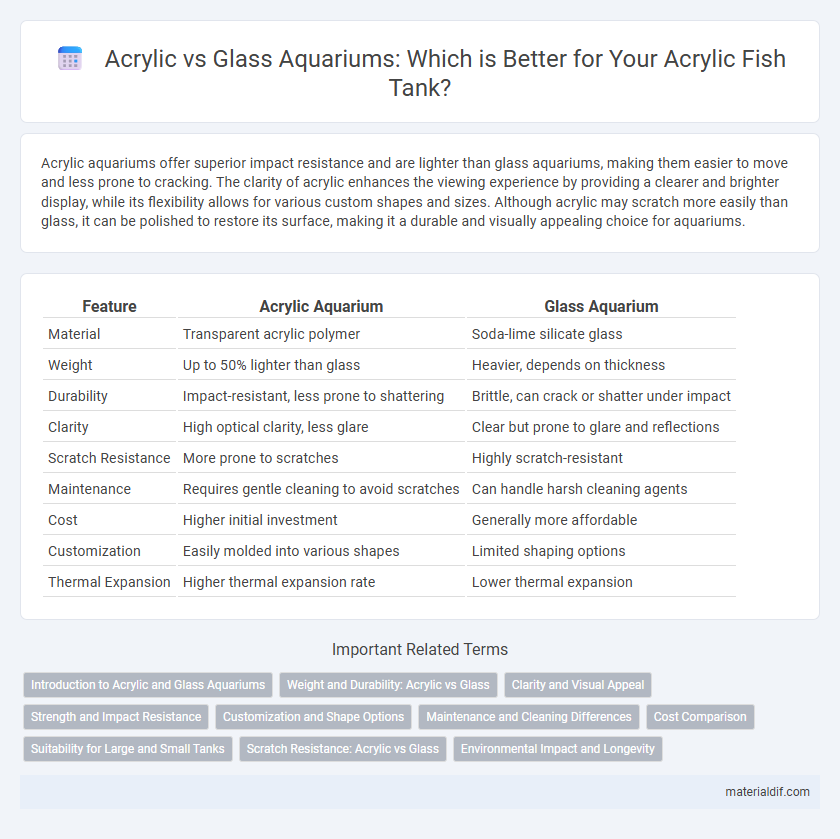Acrylic aquariums offer superior impact resistance and are lighter than glass aquariums, making them easier to move and less prone to cracking. The clarity of acrylic enhances the viewing experience by providing a clearer and brighter display, while its flexibility allows for various custom shapes and sizes. Although acrylic may scratch more easily than glass, it can be polished to restore its surface, making it a durable and visually appealing choice for aquariums.
Table of Comparison
| Feature | Acrylic Aquarium | Glass Aquarium |
|---|---|---|
| Material | Transparent acrylic polymer | Soda-lime silicate glass |
| Weight | Up to 50% lighter than glass | Heavier, depends on thickness |
| Durability | Impact-resistant, less prone to shattering | Brittle, can crack or shatter under impact |
| Clarity | High optical clarity, less glare | Clear but prone to glare and reflections |
| Scratch Resistance | More prone to scratches | Highly scratch-resistant |
| Maintenance | Requires gentle cleaning to avoid scratches | Can handle harsh cleaning agents |
| Cost | Higher initial investment | Generally more affordable |
| Customization | Easily molded into various shapes | Limited shaping options |
| Thermal Expansion | Higher thermal expansion rate | Lower thermal expansion |
Introduction to Acrylic and Glass Aquariums
Acrylic aquariums are made from a durable plastic material known for its lightweight properties and high impact resistance, making them less prone to cracking than traditional glass. Glass aquariums offer superior scratch resistance and clarity but are heavier and more fragile, increasing the risk of breakage during handling or installation. Both materials provide excellent water containment, but acrylic's flexibility and strength make it a preferred choice for larger or custom-shaped aquarium designs.
Weight and Durability: Acrylic vs Glass
Acrylic aquariums weigh approximately 50% less than glass aquariums of the same size, making them easier to handle and install. Acrylic is also significantly more impact-resistant, being up to 17 times stronger than glass, which reduces the risk of cracks and breakage. The enhanced durability of acrylic aquariums makes them ideal for environments prone to accidental bumps or requiring frequent relocation.
Clarity and Visual Appeal
Acrylic aquariums offer superior clarity with up to 93% light transmission, providing a brighter and more vibrant viewing experience compared to glass, which typically transmits around 90%. The optical clarity of acrylic remains consistent over time, resisting yellowing and maintaining color integrity, enhancing visual appeal for aquatic displays. Acrylic's flexibility also allows for more creative and seamless designs, contributing to an immersive and aesthetically pleasing aquarium environment.
Strength and Impact Resistance
Acrylic aquariums offer superior strength and impact resistance compared to glass, making them less prone to cracking or shattering under pressure. Their flexibility allows acrylic panels to absorb shocks more effectively, enhancing durability in high-traffic or child-friendly environments. This robustness ensures longer-lasting tanks that maintain clarity and structural integrity over time, even in larger or custom-shaped aquariums.
Customization and Shape Options
Acrylic aquariums offer superior customization and shape options compared to glass aquariums, allowing for seamless curves, unique designs, and larger viewing panels without compromising strength. Their lightweight nature enables easier installation of complex shapes, while glass is limited to flat panels and rectangular forms due to fragility. Acrylic's flexibility supports tailored aquascapes and innovative structural designs ideal for custom aquarium projects.
Maintenance and Cleaning Differences
Acrylic aquariums require gentler cleaning methods due to their susceptibility to scratches, often needing soft cloths and non-abrasive cleaners, whereas glass aquariums tolerate scrubbing with harder pads and standard aquarium-safe cleaning solutions. Acrylic's lighter weight and flexibility enable easier handling during tank maintenance, but its surface demands careful attention to avoid clouding and damage. Glass aquariums resist chemical erosion better but are heavier and more fragile during cleaning and maintenance tasks.
Cost Comparison
Acrylic aquariums generally have a higher initial cost than glass aquariums, with prices about 20-50% more depending on thickness and size. Maintenance expenses for acrylic are lower due to its resistant impact properties and easier repair options compared to glass, which often requires full panel replacement after cracks. Over time, acrylic offers better value for larger tanks despite the upfront investment, making it cost-effective for aquarists seeking durability and customization.
Suitability for Large and Small Tanks
Acrylic aquariums are more suitable for large tanks due to their lightweight nature, higher impact resistance, and better insulation properties compared to glass. Glass aquariums are typically preferred for smaller tanks because they are more scratch-resistant and generally more affordable. For large-scale setups, acrylic's flexibility and durability make it an optimal choice, whereas glass remains a practical option for compact aquarium designs.
Scratch Resistance: Acrylic vs Glass
Acrylic aquariums offer superior impact resistance but are more prone to surface scratches compared to glass, which is harder and more scratch-resistant. Glass aquariums maintain clarity longer due to their greater scratch resistance, making them ideal for environments with high physical interaction. Careful maintenance and using proper cleaning tools can minimize scratches on acrylic, preserving its transparency and aesthetic appeal.
Environmental Impact and Longevity
Acrylic aquariums have a lower environmental impact due to their lighter weight, reducing transportation emissions compared to heavier glass aquariums. Acrylic offers superior longevity as it is more resistant to shattering and scratches, extending the tank's usable life. Glass aquariums, while more recyclable, are prone to breakage, which can lead to increased waste and replacement frequency.
Acrylic Aquarium vs Glass Aquarium Infographic

 materialdif.com
materialdif.com